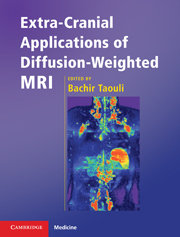Book contents
- Frontmatter
- Contents
- List of contributors
- Preface
- 1 Basic physical principles of body diffusion-weighted MRI
- 2 Diffusion-weighted MRI of the liver
- 3 Diffusion-weighted MRI of diffuse renal disease and kidney transplant
- 4 Diffusion-weighted MRI of focal renal masses
- 5 Diffusion-weighted MRI of the pancreas
- 6 Diffusion-weighted MRI of the prostate
- 7 Breast applications of diffusion-weighted MRI
- 8 Diffusion-weighted MRI of lymph nodes
- 9 Diffusion-weighted MRI of female pelvic tumors
- 10 Diffusion-weighted MRI of the bone marrow and the spine
- 11 Diffusion-weighted MRI of soft tissue tumors
- 12 Evaluation of tumor treatment response with diffusion-weighted MRI
- 13 Diffusion-weighted MRI: future directions
- Index
- References
3 - Diffusion-weighted MRI of diffuse renal disease and kidney transplant
Published online by Cambridge University Press: 10 November 2010
- Frontmatter
- Contents
- List of contributors
- Preface
- 1 Basic physical principles of body diffusion-weighted MRI
- 2 Diffusion-weighted MRI of the liver
- 3 Diffusion-weighted MRI of diffuse renal disease and kidney transplant
- 4 Diffusion-weighted MRI of focal renal masses
- 5 Diffusion-weighted MRI of the pancreas
- 6 Diffusion-weighted MRI of the prostate
- 7 Breast applications of diffusion-weighted MRI
- 8 Diffusion-weighted MRI of lymph nodes
- 9 Diffusion-weighted MRI of female pelvic tumors
- 10 Diffusion-weighted MRI of the bone marrow and the spine
- 11 Diffusion-weighted MRI of soft tissue tumors
- 12 Evaluation of tumor treatment response with diffusion-weighted MRI
- 13 Diffusion-weighted MRI: future directions
- Index
- References
Summary
Introduction
Since the early use of diffusion-weighted MRI (DWI) for detection of stroke in the brain, a whole evolution has taken place, resulting in the widespread use of this challenging technique outside the brain, particularly in oncology, where DWI has been shown to have potential for tumor detection, lesion characterization, and follow-up after treatment. Another area where DWI has shown promising results is the kidney. This is not surprising, as the main renal functions are all related to movement of fluids, such as glomerular filtration, secretion, and both active and passive tubular reabsorption. Most pathologies occurring in the kidneys are in some way related to, or give rise to, changes in water mobility. As DWI provides contrast based on changes in water proton mobility, we expect that most renal pathologies can be detected and ultimately characterized using this innovative technique.
In this review, we will discuss the use of DWI for the detection and characterization of diffuse renal disease in native and transplanted kidneys. Renal masses will be discussed in a separate chapter.
DWI acquisition and processing applied to the kidneys
In theory, any MRI readout sequence can be adapted to provide diffusion-weighted images. All that needs to be done is to add two equally large, but opposite, magnetic field gradients between an initial 90º flip angle and the actual readout. Each application has different prerequisites and the DWI sequence needs to be optimally tailored for each of those.
- Type
- Chapter
- Information
- Extra-Cranial Applications of Diffusion-Weighted MRI , pp. 32 - 45Publisher: Cambridge University PressPrint publication year: 2010
References
- 1
- Cited by



